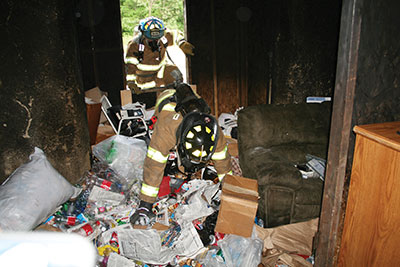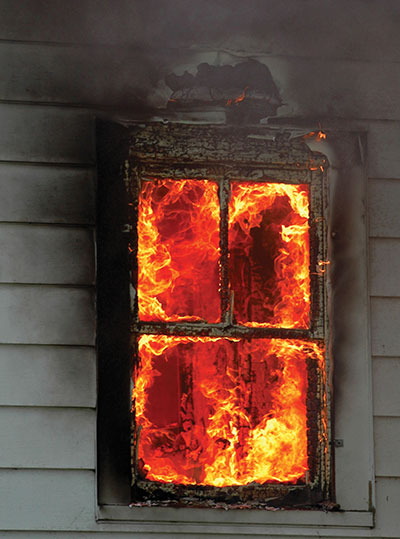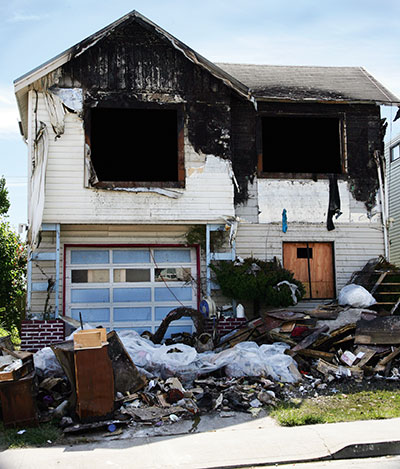
Features
Structural
Training
Editors’ pick 2014: Interior attack in hoarding conditions
"Attack 1 to command: this is a hoarder house.”
January 7, 2014
By Ryan Pennington
“Attack 1 to command: this is a hoarder house.”
If you heard those words broadcast over the radio, would you immediately pull out all interior firefighters and opt for a defensive attack?
 |
|
| Firefighters practise navigating the so-called goat paths through hoarded items; in this case, the stacks of hoarded belongings collapsed as firefighters entered the house to perform a search. Photo by Ryan Pennington |
Often when I explain to firefighters that I am studying fires in hoarding conditions, their reply is, “We just don’t go in.” Hearing these words always stirs great conversation about whether or not firefighters can safely attack a fire with hoarding conditions present.
The answer is complicated. What if there is an occupant inside? The presence of hoarding conditions does not automatically exclude an interior fire fight. In some hoarding situations, crews can identify the hoarding conditions, adjust tactics, and then attack. Successful rescues can happen in hoarding conditions.
Many variables need to be considered when analyzing the potential for an aggressive interior attack in hoarding conditions. Assessing for these variables starts before the alarm is sounded; it starts with an active pre-fire process and continues into your 380-degree size-up (look inside the occupant’s car – generally, hoarders’ vehicles are full of belongings – a sign that you are dealing with a hoarding situation – hence the extra 20 degrees in the size-up). Let’s look at some of the variables that need to be considered when deciding whether or not to enter a hoarding environment.
Pre-fire planning
Being prepared before the alarm sounds has always been of benefit to firefighters. Knowing the conditions, knowing the layout of the structure and recognizing the potential challenges that the building may present to firefighters before the alarm sounds all offer additional protection. Having different sources or agencies report the presence of hoarding is the best defence against this growing problem. The best time to identify potential hoarding is during medial calls, smoke-alarm installations, inspections of complaints by neighbours, and through drive-by assessments.
Compulsive hoarders typically do not allow people inside their homes. Family members are usually told they cannot enter, meaning first responders are often the first people to discover hoarding conditions. Many first responders who find themselves in hoarding conditions fail to note key safety points such as the volume of belongings (on a scale of 1 to 5, with 5 being uninhabitable), blocked doors and windows, spaces that are not filled, and the primary living location – for example, if the occupant sleeps in the living room.
Having a system for recording and sharing information about hoarding conditions translates into an informed decision by officers faced with hoarding situations.
These details not only help the incident commander determine whether or not to go inside, but may also assist in directing firefighters to the proper location to facilitate a rescue or make the push on the fire.
Much like pre-planning a commercial occupancy, departments should lay out the plan to survey all homes or buildings in which hoarding is identified. In this process, attention needs to be directed to:
- Blocked means of entry/egress
- Sleeping areas (may not be bedroom)
- Access issues (large amounts of belongings in yard)
- Occupancy
- Rooms that could offer points of refuge
Making the decision
After arriving on the scene of a fire, reading the pre-fire plan and identifying the presence of hoarding, the incident commander must perform the 380-degree size-up while looking for the volume of belongings and structural stability; points of entry should be identified in the size-up.
ICs should look for:
- Bulging walls
- Sagging roofs
- Collections of belongings around the exterior
- Blocked doors
- Signs of rotting structural members
This assessment should not differ much from that in a non-hoarder fire, but more attention should be paid to these details once it is suspected that hoarding is present.
 |
|
| Incident commanders should perform a detailed size-up when hoarding conditions are suspected. In particular, check for bulging walls and a deteriorating roof, which are often early warning signs for structural problems.
|
This assessment list was used by the Point Pleasant Fire Department in West Virginia, just minutes after I taught a class on hoarding fires last May. Before arriving back at my home, which is about 45 minutes away by car, I received a call from Capt. Adam Bryant, who said, “You will never believe this,” then explained that the department had been called to hoarding fire, probably before I was even outside city limits.
“It was like reading a script of a movie,” Bryant said. “Everything you said would happen, happened. We decided to not go in because we found the exterior walls were not even attached to the roof.”
A similar fire happened in southern West Virginia one day after the Wyoming County Firefighters Association hosted a hoarding fires class. Its first-arriving firefighters used the 380-degree size-up, determined that there were no occupants inside and chose the defensive posture. This was a great decision because this fire, as crews discovered, contained level 4 hoarding conditions and multiple gasoline cans stacked inside.
These experiences are typical. Because hoarders are reluctant to let people into their homes, necessary maintenance and repairs are often ignored. Over time, water leaks or pressure from contents can cause the roof and walls to deteriorate and the walls to rot and push outward. When hoarding is present it can be difficult to identify these factors because the volume of belongings can hide the effects of water damage or other structural problems.
Without access to the walls and ceilings to inspect for damage, any problems may go unnoticed for days, months or even years. Even if concerns are identified, hoarders’ compulsion to keep all their belongings, avoid moving them and prevent others from entering the home can lead to deteriorating conditions including structural members becoming rotten, overloaded or detached completely.
Had the firefighters in Point Pleasant and Wyoming County not known to take the extra time and inspect for these dangers they may have mounted an interior
attack and risked their lives.
In both cases, firefighters identified, adjusted, then attacked. Crews identified unstable structures with no occupants and opted for exterior fire fights.
Going interior
Should firefighters ever risk going in when hoarding is clearly present? Yes, but extra consideration must be given to certain factors, and a sound risk-versus-reward analysis is needed.
Indications for entry:
- Reports of occupants trapped
- Sound structural size-up
- Accessible entry points
- Acceptable number of on-scene personnel
- Small volume of fire
- Low level of hoarding conditions
The No. 1 reason to enter hoarding conditions is a confirmed report of a trapped occupant from a neighbour or family member. As always, when receiving this information, crews should gather information such as last known location of the occupant(s) or last time the resident(s) were seen. These details can point searching firefighters directly to the room in which the occupant was last seen.
 |
|
| An offensive attack is OK when hoarding is present only if officers have taken extra precautions and considered variables such as volume of fire and level of hoarding.
|
After it has been determined that there is an occupant inside who may be viable if rescued, the next step is to analyze the risk associated with an interior attack: assess the level of hoarding, the size of the fire, and the number of on-scene personnel.
Once the IC has decided that the fire is manageable and there are enough firefighters on scene, it may be necessary to think about the attack strategy: an alternative to the one-and-three-quarter-inch line stretched to the front door may be required. As hoarded belongings are collected, they can block doors; this type of situation may require crews to use windows and other means of entry to attack the fire. Once the best entry point has been determined, firefighters should use the so-called goat paths that the occupant has made through the hoarded items to navigate the interior of the home. Firefighters should not crawl or climb over stacks of belongings; the piles may collapse and trap firefighters.
A word of caution to the entering firefighters: these pathways among the hoarded items can mask the effects of a rapidly progressing fire; firefighters can be shielded from the increasing heat, and this can provide a false sense of security to advancing firefighters. Use a thermal imaging camera and/or short-blast (penciling) the ceiling for temperature checks. Interior firefighters use all five senses to assess conditions and recognize when to back out. Hoarding conditions can reduce firefighters’ awareness. Be aware of these risks and use more caution in hoarding conditions.
Rapid intervention team
Before making entry into any fire building, a properly trained, equipped and staged rapid intervention team should be in place, and this is even more important in hoarding conditions in which there are greater risks of collapse, entanglement and low-air emergencies. Doubling the normal RIT crew size is recommended for hoarding environments (if possible depending on the resources in your region).
Can we go inside hoarding conditions to save lives and fight fires? Yes, we can. But it is critical that firefighters and incident commanders prepare in advance for this type of incident through identification, adjustment and training.
Compulsive hoarding disorder is a growing problem worldwide, which means there will be more incidents in which hoarding conditions are present.
Ryan Pennington is a firefighter/paramedic for the Charleston Fire Department in Charleston, W.V. He is assigned to Station 8 and is part of the West Virginia Task Force 1 USAR team. Ryan has more than 15 years of combined fire, rescue and EMS experience. He started with a local volunteer department and continued through EMS to spend five years as a critical care paramedic. Ryan transferred to the career fire service in 2003 and has worked for the City of Charleston since 2007. He is currently a W.V. State Instructor 2, a hazmat technician, and a certified Fire Officer 2. He is very involved teaching EMS and firefighter safety across North America.
Print this page